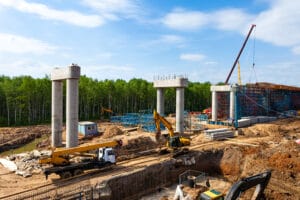Construction leaders know that project successes rely on the proper management of both the jobsite and the back-office. This article delves into improving efficiencies at the jobsite. The following best practices will lay the ground work for a successful construction project.
Implement Physical Security Measures
To properly manage your job, you must protect your assets. You can safeguard your company’s physical assets in some of the following ways:
- Install fencing to the jobsite with a limited number of access points, or geofencing if traditional fencing is not an option.
- Use site access control systems to restrict access to jobsites.
- Install surveillance systems.
- Keep jobsites illuminated.
- Hire security guards to protect high-value equipment.
- Install GPS trackers on heavy equipment and/or track who uses it.
- Register your heavy equipment in case of theft.
- Perform regular site inspections.
Improve Relationships with Third Parties
Your business’s success is not fully within your control; when third parties like suppliers, subcontractors, or trucking companies fall out of line, your business could suffer. A great control mechanism is to simply improve the relationship you have with these third parties. Have open lines of communication to ensure they’re aware of your expectations and you’re kept in the loop if something goes awry. You can also do some of the following:
- Create robust contracts that detail expectations and benchmarks.
- Have a centralized communication system so all conversations are recorded for posterity.
- Regularly audit invoices from third parties to catch any discrepancies.
- Provide timelines for deliverables.
- If a relationship sours or quality of work is not as expected, foster new relationships.
- Invest in software that tracks subcontractor performance and provides real-time updates.
Stay Lean
“Staying lean” is operating with only what you need and cutting everything you don’t. It means:
Minimizing Losses
You can do this by:
- Improving the accuracy of your projections so your materials orders are more accurate.
- Preventing theft by performing background checks, performing informal spot-checks on back-office tasks, auditing the financials, creating a whistleblower policy, training employees to spot theft or fraud, and properly segregating duties.
- Using technology to sweep the internet for different suppliers or discounts.
- Negotiating with third parties for discounts in exchange for different payment terms.
Eliminating or Reducing Bottlenecks
You can do this by:
- Checking that the order is complete and up to specifications when materials are delivered, even if those materials won’t be used right away
- Tracking the arrival of key building products so you can get workers to the jobsite exactly when needed
- Introducing software that will track inventories and automatically reorder when stocks are depleted
- Using software to help you allocate key resources so all projects are covered and moving forward
What other controls are we missing?
There are many more internal controls you can implement to improve jobsite efficiencies; we’ve only touched on a handful today. If you don’t have a robust control environment already in place, doing so can help your projects progress more smoothly and can help improve the financial outcome. Contact a leader in LaPorte’s Construction Industry Group if you would like to discuss your control environment.

